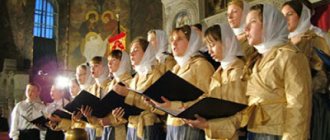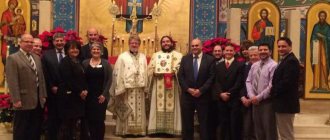Every Orthodox Christian has admired church hymns at least once in his life. When performed correctly and beautifully, spiritual singing evokes feelings of reverence, tenderness and repentance. And all this thanks to the church choir, or choir.
Both among the faithful children of the Orthodox Church and among people close to the church, there will be those who would like to devote their energy and time to serving God. One of such services can be called singing in a church choir. Unfortunately, many still do not know how to implement such a pious intention.
Features of training in a church choir
During the formation of the Church, Christians did not have the concept of a choir. The community of believers prayed and sang liturgical hymns together. After the period of persecution, attention to the beauty of church services increased, since believers could worship openly. At this time, choirs or choirs appear.
Church choirs (choirs) appeared during the persecution of the Church
In modern churches you can find several choirs that sing alternately. Such choirs are located on a raised platform, on both sides of the altar. In the Orthodox tradition, it is not customary to use musical instruments: all harmony is built on the singing of several voices.
The regent is considered to be the main person in managing the choir. Often such people have a higher musical education. The course of the service depends on their professionalism, since there is a continuous relationship between the clergyman and the choir: the priest cannot conduct a service without the choir and reader, and the choir and readers, in turn, cannot sing without the blessing of the priest.
To study in the choir you need:
- be baptized in the Orthodox Church;
- have an ear for music and a beautiful voice;
- It is desirable to have a musical education.
Advice! If you don't have any musical talent, there is an option to become a reader. To do this, you need to be able to read texts in Church Slavonic loudly and expressively.
Orthodox wedge
Author: Ekaterina IvanovaTo some extent, yes. You can learn a lot on your own in church singing, but there are nuances. There are changeable and permanent hymns for services. The constants are set out in notes: there are many collections of varying complexity - from everyday life (simpler singing) to original church works. The situation is more complicated with vocal singing: troparia, stichera, canons, etc. - this is a variable part. Samples of vocal chants are also presented in various collections. Moreover, each temple has its own traditions, peculiarities of singing voices, most often transmitted orally. If you are musically literate, you will be able to gain a good knowledge base on your own, but once you find yourself in a particular choir, you will encounter differences - sometimes small, sometimes quite serious. You will need to relearn something, get used to other execution options.
You should not immediately try to prove the correctness of your version. There can be many reasons for discrepancies; you need to understand them, and only then offer to correct something if your version turns out to be better. As they say, you don’t go to someone else’s monastery with your own rules.
If it turns out that you are the only singer in the temple, such problems, of course, will not arise, but it will also be much more difficult to deal with all the material alone. We must not forget about the rules of worship - what, how and when to sing. True, this knowledge is primarily necessary for the regent, but the singer must at least understand in general terms what he is doing and why, especially if he is alone.
In the case where there is no musical literacy, it will be incredibly difficult to master everything on your own; a great desire will be required to achieve the goal. Of course, there are audio recordings, but you have to memorize everything by heart... Without practical experience, this is very difficult to do.
I think it’s worth dwelling on this conclusion: first, you can develop a base on your own, and then you should ask permission to sing in some church choir for at least a year - in order to understand all the specifics. After all, the annual circle of divine services is very diverse, and it is difficult to think of anything better than live participation for understanding it. But, of course, any regent will be glad to have a singer who already knows something: it is easier to correct the differences in traditions than to start from scratch.
Ekaterina Ivanova, regent of the Sorrow Church in Klin
Photo: Yulia Pavlyuk
Church music Author: Irina Filippova In this episode of the TV show “The Road to the Temple” we will talk about the traditions of Orthodox church singing, about why Orthodox worship is accompanied by choral music.
Church songwriting. Part 1 Author: Natalya Dvinina-Miroshnichenko In the works of the teachers of the Synodal School - Alexander Kastalsky, Nikolai Danilin, Pavel Chesnokov, ancient Russian chants, undeservedly consigned to oblivion, found a second life: in Peter’s times they were sacrificed to “fashionable” cants, and at the turn of the 18th century In the 19th century they were literally drowned out by the style of Italian concert music.
Reproduction on the Internet is permitted only if there is an active link to the ORTHODOX WEDGE website. Reproduction of site materials in printed publications (books, press) is permitted only if the source and author of the publication are indicated.
School of Church Singing Octoplasty
Octoplasty or eight-voice is a musical system of eight voices. Voice is a special mode. Each day of the week and holiday has its own special voice.
Osmoglasie - musical modes on which all chants in the Orthodox Church are based
The first voice is solemn in nature, as it is used on the brightest and most joyful holiday of Easter.
The second voice contains a reverent and meek motive, and at the same time removes grief and sadness.
The third voice makes you think about the heavenly world, makes you think about exploits for the sake of Christ.
The fourth voice has a double quality. First it awakens joy, then it causes sadness.
The fifth voice has a soothing and at the same time sad character.
Voice six - attunes to pious thoughts and feelings.
The seventh voice is rarely used. It is touching and simple in nature.
The eighth voice has a glorifying character, magnifying the joy of the future life.
This system has been preserved in church traditions century after century and shapes its musical culture.
Singing by ear
Old Believer singing has always been heterogeneous historically and now geographically. It was divided into two directions: non-priestly and priestly. In priesthood, N.G. Denisov distinguishes two groups of parishes - Russian and southern (consisting of Old Believers calling themselves “Lipovans”). The most numerous of them is Russian, which uses the means of academic culture in its singing. But very close, beyond the western borders of Russia, there are Old Believer parishes, priestly and non-priestly, whose singing belongs to an authentic tradition without modern cultural influences, and this can be traced by specific features. There are several similar communities in Ukraine, Moldova and Poland, the majority are in the Baltic states and Romania. In the Stavropol Territory of Russia there are communities of Nekrasov Cossacks, who have earned the highest reviews and warm praise from N.G. Denisova. I would like to draw attention to the wealth that has accumulated over centuries and is still preserved within the traditional culture of the Old Believers.
The most important sign that stands out when meeting such communities is singing by ear. The pointer is no longer used, regardless of the level of hook literacy and whether the song book is open. If it is open, then they can follow the words with a pointer. Sometimes, with a pointer, they show the alphabetic meaning of the hook sign, while performing it with decorations. How does singing by ear begin? Since the singer, starting to sing a phrase, hears it (imagine to himself) completely, to the end, and simply consistently unfolds what he hears, then the pointer becomes unnecessary. The main condition for singing by ear is a good familiarity with the melody, so that a person can imagine each of its next phrases.
Znamenny singing is built on the cyclic use of lexical units - chants, which over time become well known to all singers (from good knowledge they subsequently begin to be ornamented, more or less). This type of singing proves that absolutely all people have an ear for music by nature, just like a singing voice. This “little secret” is already known to any graduate of a music school who has worked with children during their training course. It’s just that at first, not everyone has coordination of hearing with the voice, but this is achieved through regular practice (in adults, usually within 1–2 years) with more complex material, starting with litanies. There is one more condition for successful coordination of voice with hearing - to sing at approximately the same height at which a person speaks (at least at first). If it is disrupted, the singing may be out of tune.
Here we come close to the problems of female singing. The distance between a male and female voice by nature is not an octave, but a maximum of a fifth or even a quart. If women's voices rise an octave above men's, then this is much higher than the level at which singers speak, and in this case their voices sound strained and there is a tendency to constantly lower the tone. In the Lipovan communities of Romania, a very convenient, gentle way of singing is sometimes practiced: the faces are homogeneous, male and female, and each of them sings in its own tone. The distance between these tones can be a fourth or a fifth, the voices sound calm and natural.
Singing by ear solves two other problems that arise. Firstly, if the choir strays from the chosen tone, it can easily sing from another, more convenient tone, immediately in the correct scale without tuning, forgetting the previous sound. In this case, a person with a musical education has a more difficult time: without tuning, he reflexively sings from a different step of the same scale, and he ends up with an incorrect, alien character of the melody. And, secondly, those singing by ear will easily sing in their own tone, if the tone of the leader or the paired person is not suitable, for example, too high for them.
When practicing singing by ear, regular solfeggio lessons are no longer required, especially with a teacher who is not familiar with the church scale.
Church singer and academic singing school
Now let's consider whether a church singer requires an academic singing school. The most important thing is to separate its essence from its appearance. External signs are clearly visible from the outside: this is a covered sound, its vibration, agogy (changes in tempo), the use of high female voices, “leveling” the choral structure, work on the ensemble. Significant signs are completely invisible from the outside, but they are the ones that allow the singer to physiologically correct breathing and voice. Vocal lessons begin with breathing, which is universal for all vocal schools: academic, folk and pop. This breathing is deep and diaphragmatic, i.e. belly; it requires an established habit, otherwise the breath will not last long. Then you need to release the muscles of the singing apparatus and eliminate all their existing clamps - special exercises are aimed at this. These two moments of voice production are the most important; they have nothing to do with the color of the voice, its height, and even more so with an orientation towards academic musical culture, just like folk culture. High female singing was not a continuity in the Old Believers and arose in the era of the triumph of modern aesthetics, so its attitudes may still be adjusted over the years. As you can see, the answer to the question whether an Old Believer singer needs professional voice training will be positive from any point of view: of course, it is desirable or directly necessary in its universal part.
We could talk about very, very many aspects of both the ancient and Old Believer singing traditions: about its history, the formation of the manuscript school of the Vygovsky and Vetkovsky centers, about migrations and, accordingly, the transfer of the singing tradition. On the relationship between the oral and written layers in ancient manuscripts (starting with the Typographical Regulations of the late 11th - early 12th centuries) and in modern times, when books became even more unified. About experiments on the development of marked hook letters in the 17th century. About the ornamentation of the Znamenny chant and its reflection in various written sources, including sheet music... I would like to express the hope that the conversation about the tradition of Znamenny singing will be continued and supported by many scientists and practitioners who have their own exceptional and valuable observations on this vital subject. Without this item, the service will not take place, and the person coming will not say: “Here is the center of my life, and my soul sings with exactly the same voice...”.











